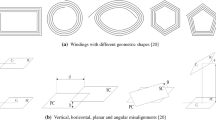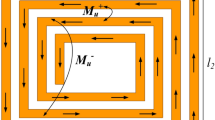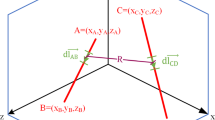Abstract
Several methods have been proposed in the literature for the calculation of self and mutual inductance. These methods include the use of complex integral analysis, the necessity of having primary and secondary coils with the same dimensions and the limitations of the ratio of the coil dimension to the distance between the coils. To overcome these restrictions, a new semi-analytical estimation method has been proposed in this paper. Calculation the self and mutual inductance by using the same basic formula which is based on Biot Savart Law prevents the formation of complex integrals and helps create a simple solution method. In order to verify the results obtained with the analytical approach, two hexagonal coils with 10 and 20 cm outer side lengths were produced by using litz wire with a conductive cross section of 1.78 mm2. The results obtained with the new approach are compared with the finite element analysis, other work presented in the literature and experimental results in order to prove the accuracy of the proposed method.









Similar content being viewed by others
References
Zhang X, Ho SL, Fu WN (2013) A hybrid optimal design strategy of wireless magnetic-resonant charger for deep brain stimulation devices. IEEE Trans Magn 49(5):2145–2148
Zhang X, Yuan Z, Yang Q, Li Y, Zhu J, Li Y (2016) Coil design and efficiency analysis for dynamic wireless charging system for electric vehicles. IEEE Trans Magn 52(7):1–4
Budhia M, Covic G, Boys J (2010) A new IPT magnetic coupler for electric vehicle charging systems. In: IECON 2010—36th annual conference on IEEE industrial electronics society, Glendale, AZ, pp 2487–2492
Lin FY, Zaheer A, Budhia M, Covic GA (2014) Reducing leakage flux in IPT systems by modifying pad ferrite structures. In: IEEE energy conversion congress and exposition (ECCE), Pittsburgh, PA, pp 1770–1777
Wang CS, Covic GA, Stielau OH (2004) Power transfer capability and bifurcation phenomena of loosely coupled inductive power transfer systems. IEEE Trans Industr Electron 51(1):148–157
Wang Z, Wei X, Dai H (2016) Design and control of a 3 kW wireless power transfer system for electric vehicles. Energies 9:10
Moon S, Moon G (2016) Wireless power transfer system with an asymmetric four-coil resonator for electric vehicle battery chargers. IEEE Trans Power Electron 31(10):6844–6854
Deng J, Li W, Nguyen TD, Li S, Mi CC (2015) Compact and efficient bipolar coupler for wireless power chargers: design and analysis. IEEE Trans Power Electron 30(11):6130–6140
Dehui W, Qisheng S, Xiaohong W, Fang C (2018) Calculation of self- and mutual inductances of rounded rectangular coils with rectangular cross-sections and misalignments. IET Electr Power Appl 12(7):1014–1019
Dehui W, Qisheng S, Xiaohong W, Fan Y (2018) Analytical model of mutual coupling between rectangular spiral coils with lateral misalignment for wireless power applications. IET Power Electron 11(5):781–786
Grover FW (1922) Formulas and tables for the calculation of the inductance of coils of polygonal form. Sci Pap Bur Stand 18:737–762
Paul CR (2011) Inductance: loop and partial. Wiley, Hoboken
Aditya K (2017) Analytical design of archimedian spiral coils used in inductive power transfer for electric vehicles application. Electr Eng 100(3):1819–1826
Jow U, Ghovanloo M (2013) Geometrical design of a scalable overlapping planar spiral coil array to generate a homogeneous magnetic field. IEEE Trans Magn 49(6):2933–2945
Xia CY, Zhang J, Jia N, Zhuang YH, Wu XJ (2013) Asymmetric magnetic unit of three-phase IPT system for achieving effective power transmission. Electron Lett 49(11):717–719
Tan P, Liu C, Ye L, Peng T (2017) Modeling and experimentation of multi-coil switching coupler for wireless power transfer systems. In: IEEE energy conversion congress and exposition (ECCE), Cincinnati, OH, pp 2579–2583
Aydin E, Kosesoy Y, Yildiriz E, Timur Aydemir M (2018) Comparison of hexagonal and square coils for use in wireless charging of electric vehicle battery. In: International symposium on electronics and telecommunications (ISETC), Timisoara, Romania, pp 1–4
Peters C, Manoli Y (2008) Inductance calculation of planar multi-layer and multi-wire coils: an analytical approach. Sens Actuators A 145–146:394–404
Tavakkoli H et al (2016) Analytical study of mutual inductance of hexagonal and octagonal spiral planer coils. Sens Actuators A 247:53–64
Tan P, Yi F, Liu C, Guo Y (2018) Modeling of mutual inductance for hexagonal coils with horizontal misalignment in wireless power transfer. In: IEEE energy conversion congress and exposition (ECCE), Portland, OR, USA, pp 1981–1986
Dalal A, Joy TPER, Kumar P (2015) Mutual inductance computation method for coils of different geometries and misalignments. In: IEEE power and energy society general meeting, Denver, CO, pp 1–5
Greenhouse H (1974) Design of planar rectangular microelectronic inductors. IEEE Trans Parts Hybrids Packag 10(2):101–109
Mohan SS, del Mar Hershenson M, Boyd SP, Lee TH (1999) Simple accurate expressions for planar spiral inductances. IEEE J Solid-State Circuits 34(10):1419–1424
Barmada S, Fontana N, Tucci M (2019) Design guidelines for magnetically coupled resonant coils with data transfer capability. In: International applied computational electromagnetics society symposium (ACES), Miami, FL, USA, pp 1–2
Song B, Cui S, Li Y, Zhu C (2020) A fast and general method to calculate mutual inductance for EV dynamic wireless charging system. IEEE Trans Power Electron. https://doi.org/10.1109/tpel.2020.3015100
Sallan J, Villa JL, Llombart A, Sanz JF (2009) Optimal design of ICPT systems applied to electric vehicle battery charge. IEEE Trans Industr Electron 56(6):2140–2149
Wheeler HA (1928) Simple inductance formulas for radio coils. Proc IRE 16(10):1398–1400
Rosa EB (1906) Calculation of the self-inductances of single-layer coils. Bull Bur Stand 2(2):161–187
Acknowledgements
This work has been conducted under the project contract 5160042 which is supported by Scientific and Technological Research Council of Turkey (TUBITAK). Authors wish to thank TUBITAK for this support.
Author information
Authors and Affiliations
Corresponding author
Additional information
Publisher's Note
Springer Nature remains neutral with regard to jurisdictional claims in published maps and institutional affiliations.
Appendix
Appendix
Magnetic flux density equation can be written by the Biot-Savart Law,
The total magnetic flux equation for calculating the triangle areas which are divided into rectangles, depending on the side length of the hexagon and the division parameters n and i is can be obtained as follows,
In order to simplify this complicated integration equation, we can divide it in four pieces and solve each part of it. As an example, only the solution of part A1 is given and the other parts can be solved by the same approach.
Since there are two symmetrical triangles within the hexagonal area, the sum of the total flux formed by the AB length is equal to the sum of the two triangular areas. Thus, the total flux equation of the triangles is,
Finally, the large rectangular area needs to be calculated. With the same approach, the total flux equation can be obtained if the integral boundaries are re-determined,
After simplification of the equations for calculating the self-inductance of a hexagonal coil, the total flux is,
By using this equation, the self-inductance for a hexagonal coil for any size and wire radius is given by,
Rights and permissions
About this article
Cite this article
Aydin, E., Yildiriz, E. & Aydemir, M.T. A new semi-analytical approach for self and mutual inductance calculation of hexagonal spiral coil used in wireless power transfer systems. Electr Eng 103, 1769–1778 (2021). https://doi.org/10.1007/s00202-020-01194-1
Received:
Accepted:
Published:
Issue Date:
DOI: https://doi.org/10.1007/s00202-020-01194-1




